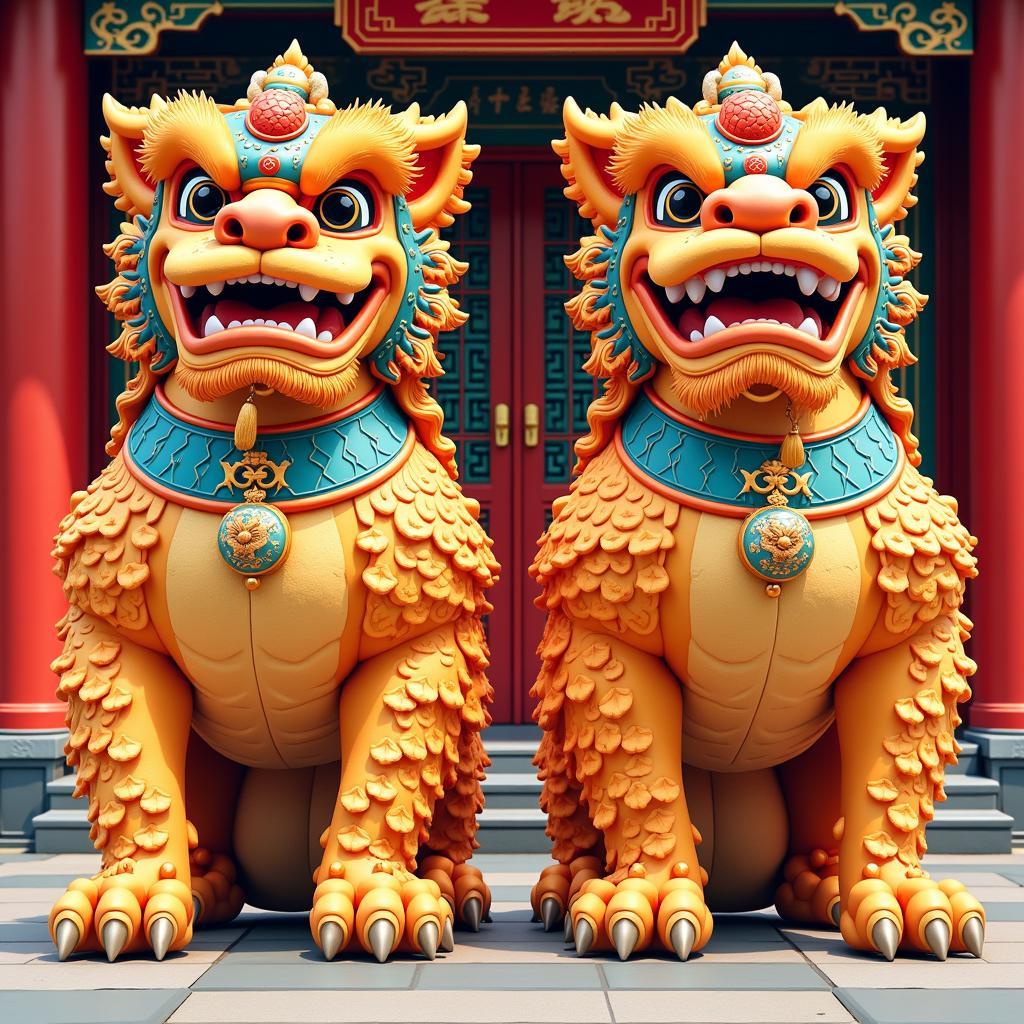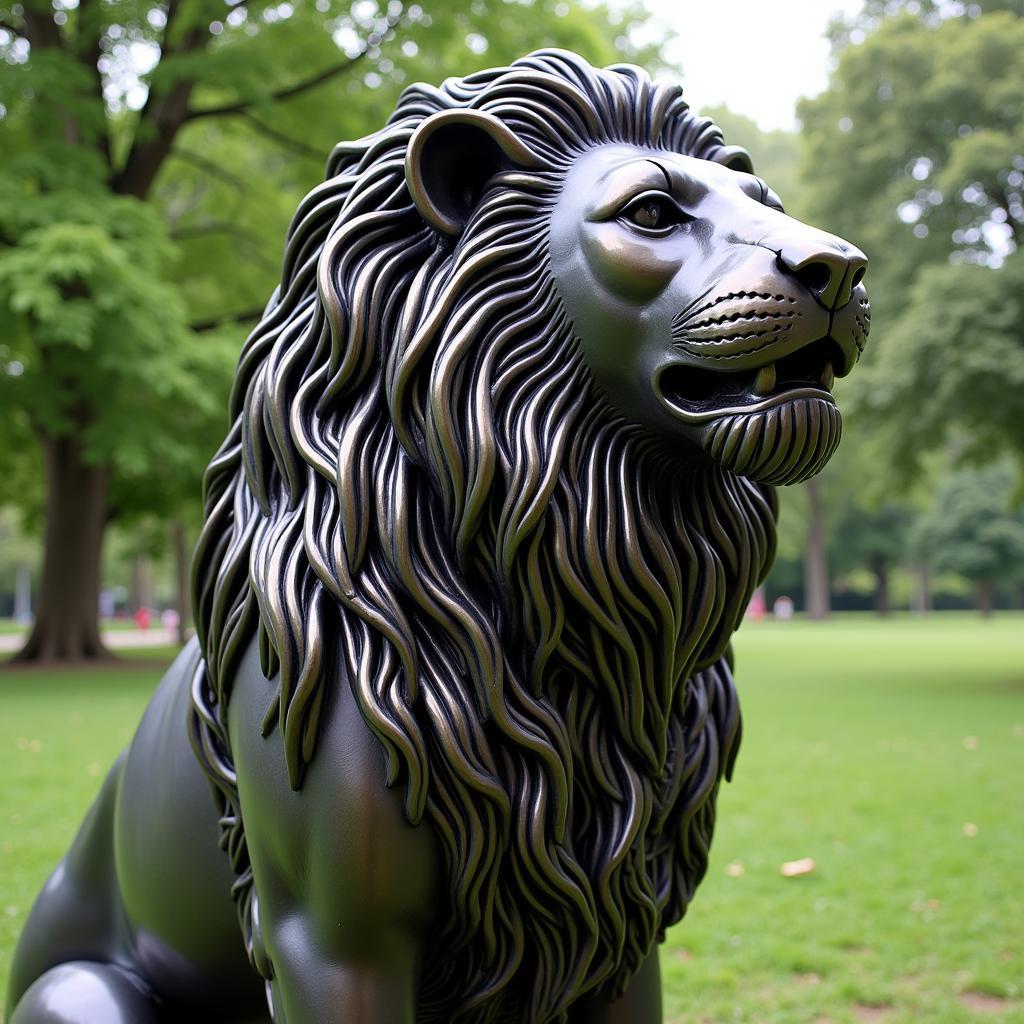Lion Statue Art has captivated civilizations for centuries, embodying strength, courage, and regality. From the imposing gates of ancient palaces to the serene gardens of modern homes, these magnificent sculptures command attention and inspire awe. But what is it about the lion that has made it such an enduring subject for artists throughout history?
The Significance of Lion Statue Art Across Cultures
Lions, often dubbed the “King of the Jungle,” hold a prominent place in mythology, religion, and cultural symbolism across the globe. In ancient Egypt, lions were associated with power and protection, often depicted guarding tombs and temples. The majestic Sphinx, with its lion’s body and human head, remains a testament to the enduring power of this imagery.
Across Asia, lion statues, particularly in China and Japan, are believed to ward off evil spirits and bring good fortune. These guardian lions, known as “Foo Dogs” or “Komainu,” often grace the entrances of temples, homes, and businesses.
 Chinese Guardian Lions Protecting a Temple
Chinese Guardian Lions Protecting a Temple
Exploring Different Styles of Lion Statue Art
The artistic interpretation of lion statues varies significantly across cultures and time periods.
Ancient Egyptian Lion Statue Art
Characterized by their grandeur and imposing presence, ancient Egyptian lion statues often depicted the animals in a stylized, regal manner. Hieroglyphics and intricate carvings adorned their surfaces, further emphasizing their symbolic significance.
Classical Greek and Roman Lion Statue Art
Influenced by their perception of lions as symbols of strength and courage, Greek and Roman artists often portrayed the animals in dynamic poses, capturing their power and ferocity. Think of the majestic lion sculptures adorning fountains and public spaces, their manes flowing, muscles taut, capturing a sense of untamed energy.
Asian Lion Statue Art
Asian lion statues, particularly those from China and Japan, are easily recognizable by their stylized features and symbolic elements. From the playful, whimsical Foo Dogs to the fierce, protective Nio guardians, these statues showcase a unique blend of realism and mythology.
 Modern Abstract Lion Sculpture in a Park Setting
Modern Abstract Lion Sculpture in a Park Setting
The Enduring Appeal of Lion Statue Art in Modern Times
Lion statue art continues to resonate with people today, transcending cultural boundaries and artistic styles. Whether serving as a focal point in a garden, a decorative element in a home, or a public monument, these sculptures evoke a sense of awe and admiration.
“The beauty of lion statues lies in their ability to connect us with something larger than ourselves,” says renowned sculptor, Anya Patel. “They remind us of the power and majesty of the natural world, while also reflecting our own aspirations for strength and courage.”
Conclusion
Lion statue art stands as a testament to the enduring power of symbolism and artistic expression. From the imposing guardians of ancient civilizations to the elegant sculptures gracing modern homes, these magnificent creations continue to captivate and inspire. Whether drawn to their historical significance, cultural diversity, or simply their aesthetic beauty, one thing is certain: lion statue art remains a timeless expression of power, majesty, and the indomitable spirit.
FAQ
1. What materials are lion statues typically made from?
Lion statues are crafted from a variety of materials, including stone, bronze, marble, granite, and resin. The choice of material often depends on the desired aesthetic, durability, and budget.
2. Where can I purchase a lion statue?
Lion statues are available for purchase from a variety of sources, including art galleries, antique shops, online retailers, and specialized sculpture studios.
3. How do I care for a lion statue?
The care required for a lion statue depends on the material it is made from. Generally, regular cleaning with a soft cloth and mild soap solution is sufficient. Outdoor statues may require additional protection from the elements.
4. What is the significance of the pose of a lion statue?
The pose of a lion statue often carries symbolic meaning. For instance, a lion depicted with its mouth open is thought to represent power and strength, while a lion with its mouth closed symbolizes peace and tranquility.
5. Are there any cultural taboos associated with lion statues?
It’s always a good idea to be mindful of cultural sensitivities when displaying lion statues. In some cultures, placing a lion statue facing inwards towards a home is considered bad luck.
Need Help Choosing the Perfect Lion Statue?
Contact us! Our team at Art Deco Garden Statues is passionate about helping you find the perfect piece to enhance your space. Whether you’re searching for a dramatic centerpiece or a subtle accent, we offer a wide selection of lion statues to suit every style and budget.
Call us at: 02462573573
Email us at: [email protected]
Visit our showroom: Savico Megamall, 7-9 Đ. Nguyễn Văn Linh, Gia Thụy, Long Biên, Hà Nội 10000, Việt Nam.
We’re here to help you bring a touch of timeless artistry to your world.